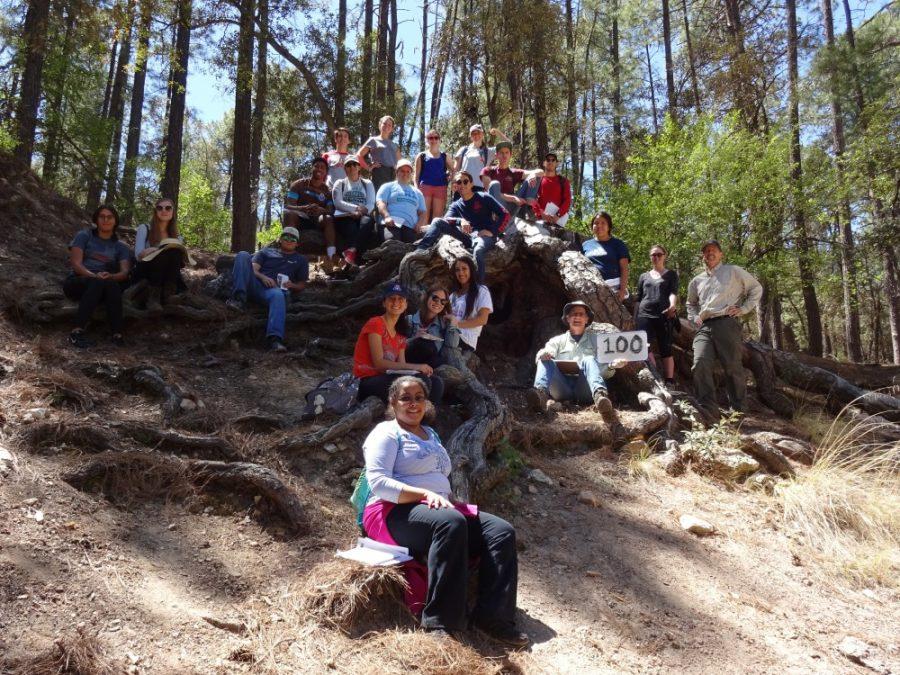Last Saturday, UA students and faculty celebrated the 25th anniversary—and 100th field trip—of a beloved geoscience field course.
In a modern classroom setting, it is almost unheard of for a class to be comprised mostly of field trips. Enter GEOS 195D, Sense of Place.
The class was originally created by geosciences professor emeritus Bob Butler from the geosciences department. When the class first started in 1993, the UA was experiencing an unprecedented freshman dropout rate and administrators were desperate to raise retention rates.
In lieu of a face-to-face discussion with students about faculty research, Butler suggested field-based instruction instead. The course is designed to utilize the combined knowledge of two professors, each with different skills and perspectives.
Currently, the class is taught by Laboratory of Tree-Ring Research dendochronology associate professor Paul Sheppard as the ecology specialist and adjunct lecturer Gary Huckleberry as the authority on geology. The class meets once a week for several hours before a weekend field trip to discuss what aspects of nature they will be focusing on and learning about.
There are four day-long trips over the course of the semester—one per month, each exploring a different aspect of Tucson’s natural surroundings. The current trips travel to the Santa Cruz Basin, Hohokam archaeological sites, the Tucson Mountains and Mt. Lemmon.
RELATED: Hard rock at Old Main: UA mining students compete to drill massive boulder
Students keep detailed field journals with notes and sketches describing the things they observe, then turn in a summary of their trip that integrates everything they learned together with a larger focus on how all these different aspects collectively form a particular place.

Each trip is designed to give students a different perspective, and the class as a whole is meant to help students translate all those different perspectives into one complete representation of Tucson.
The course is open to all students and every major is welcome. The content attracts native Tucsonans, international and out-of-state students alike.
“I’ve really liked this class because I wanted to learn more about Tucson,” said astronomy and physics undergraduate Emily Walla. “I’m not from Arizona; I’m not from the Southwest at all, and being able to come here and learn all the history that I’ve learned about my home in one course is incredible.”
RELATED: Desert microorganisms, weather endangered by climate change
Students in the course have an opportunity to not only learn about how Tucson was formed in terms of physical elements but also about past cultures and how they survived and lived in this desert region for so long. On a few of the trips, students have the opportunity to taste local foods, such as mesquite pancakes and saguaro blossom tea.
“I really like how it combines geology and archaeology, and almost like sociology too; you’re learning a lot about where you live, which is super cool because you don’t get that sort of personalized learning experience anywhere else,” said Laura Vargas, a physiology undergraduate.
The course’s main goal is to help students develop a sense of place in Tucson and beyond.
“They take you to these places that you wouldn’t really think to look around, to get a feel for Arizona and the Tucson area, but you get to see these cool little niches that really give you a better feel for the desert and the ecosystem, really just things that you wouldn’t think about, but it makes living in Tucson more endearing,” said engineering undergraduate Allan Chon.
Along with the appeal of a field trip-based class, students said it is partially the enthusiasm of the professors that really makes the class worthwhile.
For the past 13 years, Sheppard and Huckleberry have taught the class together. They have developed relationships with students that transcend the boundaries of the classroom, in part due to the intimate nature of the course.
“In the field, there’s a different type of bonding that takes place,” Sheppard said.
The class is designed so students have unique access to their professors and the scientific knowledge they bring with them. It is also a goal for Huckleberry and Sheppard that students have an opportunity to bond with their peers over the course of the semester and hopefully create lasting friendships.
“The one credit is not a motivator for the course; it’s a matter of taking these trips,” Huckleberry said.
Follow Rebekah Ulmer on Twitter.









